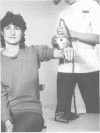Abstract
Shoulder abduction fatiguability has been measured using a hand held myometer in normal subjects and patients with peripheral neuromuscular diseases. An index of fatiguability was based on the decline in force over a series of ten maximum voluntary contractions performed in under a minute. The technique was repeatable and well tolerated. Patients with myasthenia, mitochondrial myopathy and motor neuron disease tended to show excess fatiguability independent of muscle strength. Serial measurements demonstrated alterations in fatiguability but not necessarily strength, associated with changes in symptoms.
Full text
PDF




Images in this article
Selected References
These references are in PubMed. This may not be the complete list of references from this article.
- Arendt-Nielsen L., Mills K. R. The relationship between mean power frequency of the EMG spectrum and muscle fibre conduction velocity. Electroencephalogr Clin Neurophysiol. 1985 Feb;60(2):130–134. doi: 10.1016/0013-4694(85)90019-7. [DOI] [PubMed] [Google Scholar]
- Edwards R. H., Hill D. K., Jones D. A., Merton P. A. Fatigue of long duration in human skeletal muscle after exercise. J Physiol. 1977 Nov;272(3):769–778. doi: 10.1113/jphysiol.1977.sp012072. [DOI] [PMC free article] [PubMed] [Google Scholar]
- Edwards R. H. Physiological analysis of skeletal muscle weakness and fatigue. Clin Sci Mol Med. 1978 May;54(5):463–470. doi: 10.1042/cs0540463. [DOI] [PubMed] [Google Scholar]
- Hosking J. P., Bhat U. S., Dubowitz V., Edwards R. H. Measurements of muscle strength and performance in children with normal and diseased muscle. Arch Dis Child. 1976 Dec;51(12):957–963. doi: 10.1136/adc.51.12.957. [DOI] [PMC free article] [PubMed] [Google Scholar]
- Jones D. A., Bigland-Ritchie B., Edwards R. H. Excitation frequency and muscle fatigue: mechanical responses during voluntary and stimulated contractions. Exp Neurol. 1979 May;64(2):401–413. doi: 10.1016/0014-4886(79)90279-6. [DOI] [PubMed] [Google Scholar]
- Lindstrom L., Magnusson R., Petersén I. Muscular fatigue and action potential conduction velocity changes studied with frequency analysis of EMG signals. Electromyography. 1970 Nov-Dec;10(4):341–356. [PubMed] [Google Scholar]
- Stokes M., Young A. The contribution of reflex inhibition to arthrogenous muscle weakness. Clin Sci (Lond) 1984 Jul;67(1):7–14. doi: 10.1042/cs0670007. [DOI] [PubMed] [Google Scholar]
- Wiles C. M., Edwards R. H. The effect of temperature, ischaemia and contractile activity on the relaxation rate of human muscle. Clin Physiol. 1982 Dec;2(6):485–497. doi: 10.1111/j.1475-097x.1982.tb00055.x. [DOI] [PubMed] [Google Scholar]
- Wiles C. M., Jones D. A., Edwards R. H. Fatigue in human metabolic myopathy. Ciba Found Symp. 1981;82:264–282. doi: 10.1002/9780470715420.ch16. [DOI] [PubMed] [Google Scholar]
- Wiles C. M., Karni Y. The measurement of muscle strength in patients with peripheral neuromuscular disorders. J Neurol Neurosurg Psychiatry. 1983 Nov;46(11):1006–1013. doi: 10.1136/jnnp.46.11.1006. [DOI] [PMC free article] [PubMed] [Google Scholar]



